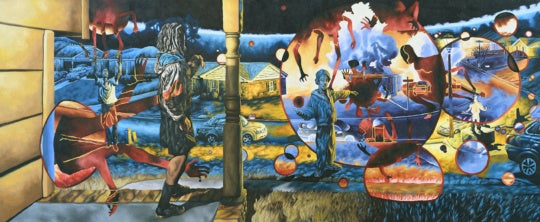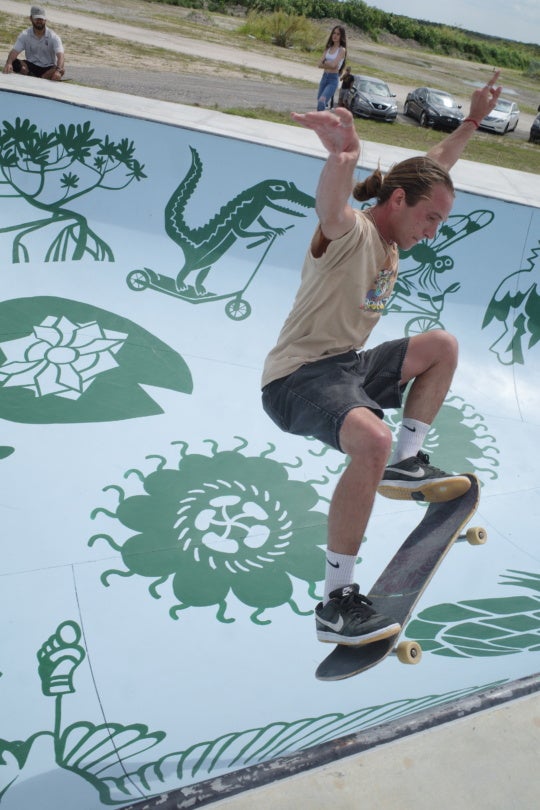
When you live in Maine, springtime never arrives quickly enough. The doldrums of mid-March often propel the residents of this summertime Vacationland to jump in our cars and drive south—anywhere south. My recent trip snaked through New York, Philadelphia, Baltimore, Richmond, and then down to the three-city triangle of North Carolina to work with a Maine expat, Rachel Herrick. From the moment I saw Rachel’s MFA thesis exhibition at the Maine College of Art, I knew that I wanted to work with her again, and, two years later I had the good fortune of doing so on her new Publication Studio Portland (other) book: Obeast: A Natural & Unnatural History. Luckily, the book launch coincided with her most recent solo exhibition at Raleigh’s Flanders Gallery, The Museum for Obeast Conservation Studies [March1-30, 2013]. After the book release, we had a chance to chat about the book, her work, and being a working artist in North Carolina.
Daniel Fuller: Your project, The Museum for Obeast Conservation Studies (MOCS), which was recently at Flanders Gallery in Raleigh, mimics museological practices and the experience of visiting a museum whose collections combine scientific, artistic, cultural, and historical artifacts. How does the authoritative voice of the museum lend credence to the fictional obeast? Is MOCS a theatrical space, a fantastical satire of traditional institutions, or is it a site for serious education and exchange?
Rachel Herrick: Yes. All of the above. The blurry and fractal boundaries between each of these modes are part of the work. I’m not sure it’s useful or even possible to separate them.
The MOCS project’s mimicry of museological practices satirizes the ways in which ideas are unconsciously and automatically legitimized through institutions like museums and science. Ideas are assumed to be factual if they possess the correct visual signifiers; my goal is to identify those visual signifiers and use them to create an absurd narrative that seems almost plausible. The dissonance created for viewers by this real/unreal narrative is appealing and important to me.
Obesity is a timely and personally relevant foil for these ideas. In light of the “obesity epidemic,” American culture has a fear and loathing of fat that is disproportionate to the actual scientific data on the subject. Alarming sound bites get dolled up in legitimizing visual cues on the evening news, and voila!—feeling gets disguised as thinking. It’s almost magic. In MOCS I satirize this dynamic by using the same legitimizing tropes to authenticate the obeast as are used to perpetuate fat bias.
DF: With a project that some might consider controversial, you must continuously be aware of the power of language to either facilitate or thwart an audience’s experience with your art. How aware are you at all times of how you frame the questions, answers, and ways you speak about the obeast?
RH: I am aware that language has a huge impact on audiences, but also that language is subjective and amorphous in ways I can’t control. I try to be thoughtful about things I say or write, but this project has taught me that there is absolutely no way to phrase or explain this work that will resonate with everyone. Someone will inevitably be offended, and usually it has less to do with my message delivery than how that person filters what I said through his/her experiences and biases. Miscommunication is normal and fascinating, so I try not to sweat it much.

DF: Who do you identify as your audience, how do you attract and engage them, and how do you try to diversify and build new audiences? How, if at all, do you see your role as an artist changing when you show in commercial gallery, museum, or alternative space?
RH: My audience seems to change somewhat depending on where the work is being shown. For example, I didn’t previously think that kids were part of my audience until I had a show in Lawrence, MA, in a space that organized after school programs. To my delight and surprise, the students really got into the work and asked open and honest questions about the parts they didn’t understand. I’ve learned that this work resonates with a lot of different people, and given that I’m not pushing an agenda about the “right” reading of my work, I think that makes my audience pretty broad. I also think it helps that the array of media MOCS incorporates is so diverse and interactive. There’s something for everyone: videos, sound, animation, games, didactic signage, as well as more straightforward ‘arty’ components.
Although my aesthetic goals remain pretty consistent, my role as the artist does change with the type of venue the work is in, because each prepares the audience in a different way. Visitors to a museum enter the space prepared to see art that might challenge them—in fact they might come seeking that engagement with ideas. So, museum-goers tend to spend a little longer with the work trying to figure it out. Community-oriented spaces (like the one in Lawrence) tend to require the most from me as an envoy for the work, but I try to resist the urge to dictate and instead facilitate community conversations when possible. Commercial gallery audiences can be sometimes be conservative with their willingness to engage with ideas, but it’s fun how enthusiastic collectors can be once they’ve invested in the project (emotionally as well as financially). I guess in a way, my role as artist changes not so much in the type of things I say about the work, but in the number of times I have to say them.
Now let’s chat about the book!
DF: I have always seen your work as extremely intellectual (besides being very aesthetically developed), but I can also understand where your installations might cause confusion from the gallery viewers. As an artist, you seldom want to prescribe meaning to the content of your work, but I wonder about your role as an ambassador or artistic interpreter of your own work. The aim of the second book in the set is place your work in a scholarly context. How important do you find it to convince viewers of the seriousness of satire?

RH: I don’t find it important to convince anyone of anything. That’s a futile endeavor, as far as I tell. The Obeast project can be accessed at different levels, and I think all of them are fine (or I wouldn’t have made them that way). This project pokes (ruthlessly at times) at some personal and often unexamined issues, so people mentally approach this work from an infinity of places and all take away something different. I think that’s great. I would find it counterproductive to dictate an agenda; my favorite art asks questions rather than provides answers.
With the Obeast project, there are a number of ways to engage with the work: There are of course the Museum for Obeast Conservation Studies (MOCS) installations themselves, which incorporate several media formats with varying levels of didacticism about the obeast narrative—everything from museum signage to interactive games. Within these spaces, there is absolutely nothing outside the narrative arc of the project (not even my name), but should viewers want to engage more with the context and ideas behind the work, there is usually a binder at the gallery with information. Further, the MOCS brochure that they take with them from the exhibit can lead them to the MOCS website where they can learn more about obeasts and become members of the museum or fans on Facebook. Should they want even further engagement, a quick google search can lead them to my artist website or to other online discussions/resources. And now there is the book set, which elaborates on both the obeast narrative (book one) and the social and academic discourse that is happening about the work (book two).
So, the succinct answer is that I’m more like a facilitator than an ambassador. To my mind, I am just creating more engagement options, not requirements.
DF: For this two-book set, you truly enlisted a tour-de-force cast of scholarly contributors. As a result of their insightfulness and their distinctive interpretations, have you learned anything about your own practice from what they have written?
RH: I did. I learned something from every article. It’s always revealing to see what parts of the project people choose to focus on and the connections they make between what I’m up to and pop culture/politics/ theory. For example, art historian Stefanie Snider wrote a stellar piece that contextualizes MOCS in terms of both fat studies and contemporary art history. This article was informative for me because although I was familiar with the other artists and written references she discusses, I hadn’t compiled all these connections and inspirations together into one cohesive picture to examine side by side with my own work. It prompted me to reexamine how my art functions compared to that of great artists like Fred Wilson, Guillermo Gomez-Pena, and Jimmie Durham—specifically the similarities and differences in the controversies surrounding their work compared to my own. Fat is still not widely considered an identity, but rather as a personal failing that deserves to be stigmatized. It’s no wonder then that folks sometimes get cranky about my suggestion that stigmatizing a common physical feature is foolish and counterproductive to the goal of healthy living that we all share.
Writer and comedian Jenny Hagel’s essay on the role of comedy in activism is a fun romp through an idea that I’m very interested in. My own research on hoax and satire had led me to the classics like Jonathan Swift, P. T. Barnum, and Andre Breton, but I hadn’t thought as much about how important humor is for information dispersion in today’s news. As Jenny suggests, satire delivered to a wide enough audience has the power to derail presidential campaigns.
And finally, historian Carl Dyke’s essay on the dynamics of meta-activism was really interesting to me because he doesn’t see my work landing squarely in any activist camp, but rather kind of dancing around making fun of the way people anxietize their lives in general. For the record, I’m married to Carl, but he surprised me with some of the connections he made between the obeast work and my earlier work on lifeguarding techniques and mynah bird handling. His essay suggests that my problem is problems. I hadn’t thought of it like that before.
DF: Between creating the book and creating the work in your current exhibition, there are divergent attitudes about presenting and producing—stepping aside and maintaining a secondary role in relation to the writers versus actually creating projects for the gallery. Can you discuss the idea of having to be ‘hands off’ while allowing the writers to do what they do best?
RH: That hands on/hands off collaborative dynamic is actually present throughout this project and is one of my favorite parts of it. With collaborative studio projects, I’ve found it works best to recruit talented people and just let them do what they do. I give them only enough direction to feel comfortable participating, because I want them to bring their ideas to the project, not just try to execute mine. In the case of the obeast tagging video, for example, the actors and I had a conversation over dinner a couple days before the shoot where we talked about obeast tagging as if it was a real scientific study they were doing. On the day of, we just got into character and stayed there. With video, this improvisational technique can require some creative editing on the back end, but the work turns out so much better and is much more fun to do. Although I tend to be pretty meticulous—controlling, if I’m being honest—working alone in the studio, I think it’s important not to be a dick to the people you work with, and giving people space is my way of doing that.
This was my approach to the second book as well: Recruit smart, articulate people, give them a broad prompt and let them go to town. In this case, I asked them to write from the places where the obeast project intersected with whatever they were thinking about/interested in at the time. I was available to talk through ideas or to provide more background on the project if they needed it, but only in a supporting role. I was surprised and not at all surprised by the quality of thought and writing that was produced. That’s part of the fun of working like this.

DF: Can you talk about finding your cultural niche within Raleigh? I know that you work in the Bonded Llama Studios, which houses a number of interesting folks. Have you found conceptual allies who can help you confront the challenging ideas behind your work?
RH: Raleigh is an interesting place to be an artist because the art scene feels like it doubles in size every two years. There are a lot of talented artists from many different backgrounds in terms of geography and artistic practices. Everyone brings something unique to the local art community. As far as conceptual allies, there are always people happy to chat about art over beer and hushpuppies. One of the challenges facing Triangle artists (and therefore the local art scene) is that many of us are focused on showing our work outside of this area and maybe don’t have as much time to develop local partnerships as we might like. We’re working on this though. There are a lot of alternative spaces here (empty relics from the tobacco industry, for example) that are begging for artistic projects.
As far as my studio goes, Bonded Llama is a 1920s warehouse office building surrounded by kudzu. It’s not glamorous, but it’s home to eight artists working in media ranging from paper-making to painting, photography, installation and sculpture. My studio mates keep things fun and are good sports about occasionally getting jumped by an obeast.
DF: What are the advantages of working in the sprawl of the Research Triangle? Do the three cities (Raleigh, Durham, and Chapel Hill) provide something that one “local” community cannot?
RH: History and industry have shaped each point of the Triangle as well as the areas in between. The region has class and racial complexity, as well as rural/urban and town/gown splits, which is a usefully complicating context for an artist interested in stigma and identity like I am. I’m not from this area originally, but in the ten years I’ve been here I’ve noticed the tone of this place influencing my work. I think the Triangle’s sprawl is part of that; there’s kind of no quick way to get where you’re going, so eventually you accept that and mellow.
Since you ask, the advantages of the sprawl are subtle, but here are some that pop to mind: cheap studio rent, a lowered sense of competition between artists (because we’re not all on top of each other), and plenty of long drives to think deep thoughts. An incidental perk about the way this area is laid out: Each city is just far enough away from the others to have a vibe that is uniquely its own, but close enough that it’s not an ordeal to navigate between them.
DF: Each of these cities is inexplicitly tied to their large universities and, basketball aside, the universities are represented by their respective art museums (Raleigh has NC State’s Contemporary Art Museum; Durham has Duke’s Nasher Museum, and Chapel Hill has UNC’s Ackland Museum). It is quite unique to have this many regional art institutions tied to colleges. Can you talk about how this informs the area’s art scene?
RH: As representatives of their respective universities, these museums enrich the Triangle with ambitious, conceptually driven exhibition programming. Sometimes the larger Art World can feel a bit removed from North Carolina, but these museums continually infuse the area with fresh, intellectually-rigorous work by artists from a diversity of backgrounds. It prevents the local art scene from getting too insular or self-referential. This is not to say, however, that NC culture is not valued or represented by these universities. Apart from the Nasher, Duke also has its Center for Documentary Studies, which regularly hosts exhibitions of documentary work (often, in my experience, with an NC focus). NC State’s Gregg Museum of Art & Design collects and exhibits work relevant to the studies of the students and to the local community as a whole.
As a final note: beyond the museums themselves, the universities you named (as well as Meredith College, Peace University, and Shaw University, etc., which are also here) also contribute to the local scene by staffing their art programs with talented faculty who bring a lot to the local art conversations.
DF: And, lastly, you have a show coming up in Atlanta?
RH: Yes! The Museum for Obeast Conservation Studies is coming to Atlanta in April as part of Something in Particular: A Review of Today’s Southern Artist in the L1 Gallery at the Telephone Factory Lofts. The opening reception is April 27. The show is set in a 9000 square-foot space and will have work by ten contemporary artists from all around the South. The talent in this group is really exciting and inspiring. I can’t wait.
Daniel Fuller is the Director of the Institute of Contemporary Art at Maine College of Art and is the co-Director of Publication Studio Portland (other) in Portland,ME. Fuller came to Maine from the Philadelphia Exhibitions Initiative, a program of The Pew Center for Arts & Heritage, where he worked as the Senior Program Specialist. Fuller holds a Bachelor’s Degree in Painting from Towson University and a Master’s Degree in museum studies from Syracuse University. He has contributed writing to Art in America, Art:21, Afterall, ArtAsiaPacific, and Art on Paper.




